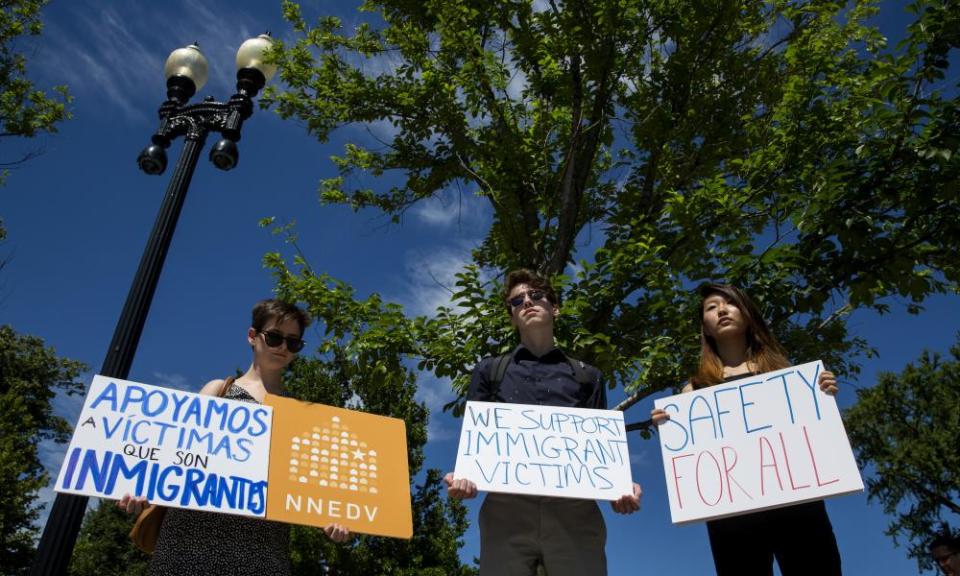Trump travel ban Q&A: what happens next?
The US supreme court has reversed lower court rulings, allowing the immigration order to take partial effect. Here’s what that means

A watered-down version of the Trump administration’s “travel ban” is to take effect over the summer following a supreme court decision on Monday reversing a series of federal court rulings on the ban.
The decision by the US’s highest court raises a number of questions about what the new ban will mean for people in the six Muslim-majority nations affected, as well as for a president who has been repeatedly stymied by the judiciary in the first five months of his administration.
Q: Has the supreme court made a determination as to whether Trump’s travel ban is constitutional?
A: No. The key aspects of the ban had been stayed – temporarily blocked – in their entirety by federal courts in Maryland and Hawaii, rulings subsequently upheld by federal appeals courts. On Monday, the supreme court agreed to hear arguments on the constitutionality of the ban this fall, and allowed certain aspects of it to take effect in the meantime.
Q: Which countries does this partially reinstated ban affect?
A: The ban affects travelers from Syria, Iran, Yemen, Libya, Sudan and Somalia. A prior version of the ban also included travel by Iraqi nationals, but the administration dropped the country from its list in a revised version of the ban signed in early March. The removal was reportedly requested by the defense secretary, James Mattis, on the grounds that it might hamper coordination in the two countries’ attempts to defeat Isis.
Q: So if it’s partially reinstated, who is affected and who isn’t?
A: The supreme court says the reinstated ban should only apply to “foreign nationals who lack any bona fide relationship with a person or entity in the United States”, a phrase that will undoubtedly be subject to a great deal of parsing over the coming months.
This means that individuals from the affected countries who have family in the US, or legitimate work or educational reasons for travel, should not be included in the revamped ban, a huge contingent of those who would have otherwise been affected.
The new ban also will not apply to those who already have a valid visa to enter the US, unlike the original ban, which left otherwise credentialed passengers stranded at airports worldwide, sparking outrage and protests.
Prospective tourists from the six outlined countries with no family connections to the US are the most likely to be affected by the ban, as well as refugees fleeing violence in the region, especially from the civil war in Syria.
The court specifically notes that “a nonprofit group devoted to immigration issues may not contact foreign nationals from the designated countries, add them to client lists, and then secure their entry by claiming injury from their exclusion”.
Q: How many people affected by the original travel bans will be affected by this partial reinstatement?
A: That number is difficult to pinpoint as yet. According to state department data, in fiscal year 2015, about 60,000 people from the affected countries received non-immigrant visas – about half of which went to Iran. That number, though, includes many people with certain visas exempt from the original bans and people who would have a “bona fide relationship with a person or entity in the United States”.
Q: Who decides what constitutes a bona fide relationship?
A: The Trump state department would make this determination, so the exact criteria it uses merits watching as the ban rolls out this summer.
Q: Can anything stop the ban from going into effect now?
A: In theory, the Trump administration could withdraw its ban, although that seems unlikely. But there is no entity that can challenge the Trump administration’s plans until the court hears arguments in October.
Q: When does the ban go into effect?
A: While there is no official answer to this question, a Trump administration memo issued earlier this month suggested a 72-hour rollout window for a revised version of the ban. That would mean Thursday morning.
Q: How did the supreme court justices vote?
A: None of the justices dissented with the unsigned decision. The three most conservative justices – Clarence Thomas, Samuel Alito and Neil Gorsuch – intended to rule that the ban should be allowed to go into effect in full, but accepted the partial reinstatement as a compromise.
Q: What will the court’s eventual ruling mean for the ban?
A: The 90-day ban on visas and the 120-day suspension of the US refugee admittance program may both have already come and gone by the time the court issues a ruling, which will not be earlier than October. That decision will have a major impact on any extensions or subsequent versions of the order that the White House attempts in the future, however.
Q: Does this decision constitute a political victory for Trump?
A: It’s difficult to argue otherwise. Even if the ban that goes into effect is strongly watered down from what it was intended to be, Trump has more of his policy agenda in place today than he did yesterday. It also gives the president the opportunity to frame the decision as proof his administration was right all along about the ban, even if in reality it’s still too early to say.

